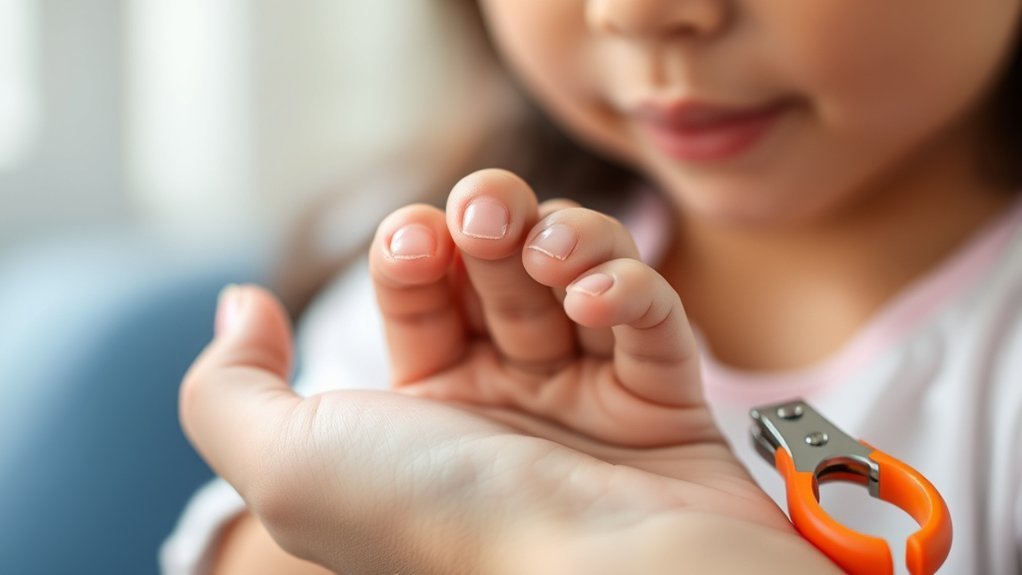As a parent, you know that maintaining your child’s health and hygiene is a top priority. Nail trimming might seem like a small task, but it plays a significant role in preventing infections and promoting good habits. Establishing a routine not only keeps their nails neat but also teaches them about self-care. Understanding the importance of nail care can set the stage for responsible adulthood, but do you know when to start and how to do it safely?
The Importance of Nail Trimming for Children
While you might think of nail trimming as a simple grooming task, it plays an essential role in your child’s health and well-being. Keeping your child’s nails trimmed helps prevent painful hangnails and reduces the risk of infections.
Overgrown nails can harbor dirt and bacteria, leading to potential health issues. Additionally, maintaining short nails can minimize the chances of your child scratching themselves or others, which is especially important for infants and toddlers.
Regular nail care also contributes to good hygiene habits, teaching your child the importance of self-care from a young age. By prioritizing nail trimming, you’re not just ensuring neatness; you’re actively protecting your child’s health and fostering a sense of responsibility as they grow.
When to Start Trimming Your Child’s Nails
When should you start trimming your child’s nails? Ideally, you should begin as soon as your baby’s nails are long enough to pose a scratching risk, which can be within the first few weeks after birth.
Those tiny nails grow quickly, and it’s important to keep them neat to prevent any accidental scratches to their delicate skin or yours. Regular trimming can also help instill good hygiene habits as they grow.
Best Practices for Safe Nail Trimming
To guarantee safe nail trimming, it’s vital to create a calm environment where both you and your child feel comfortable. Choose a well-lit area and use appropriate tools, like baby nail clippers or scissors. Make certain to trim nails after a bath when they’re softer. Hold your child’s hand gently but firmly, and keep distractions minimal.
Here’s a quick reference table for best practices:
| Best Practices | Tips |
|---|---|
| Timing | Trim after bath time |
| Tool Selection | Use baby nail clippers |
| Positioning | Sit in a comfortable spot |
| Distraction Techniques | Sing a song or tell a story |
Following these steps will help guarantee a positive experience for you and your child during nail trimming.
Teaching Kids About Nail Care
Understanding the importance of nail care early on can set the foundation for lifelong hygiene habits. Start by explaining why clean, trimmed nails matter—not just for appearance, but for health too.
Teach your kids how to wash their hands properly and include nail cleaning in that routine. Show them the right way to trim nails safely, emphasizing that it’s not just a chore, but a way to take care of their bodies.
Encourage them to pay attention to their nails’ growth and condition, making it a part of their self-care. By fostering this awareness, you’re instilling responsibility and hygiene practices that will serve them well into adulthood.
Signs of Healthy Nails: What to Look For
Healthy nails can be a reflection of overall well-being, so it’s important to know what to look for as part of your child’s nail care routine.
First, check for a smooth surface; healthy nails should be free from ridges or spots. Their color should be uniform, typically a healthy pink, indicating good circulation.
Pay attention to the nail shape; they should be gently curved, not flat or overly curved. Moisture is key, too—dry, brittle nails can signal nutritional deficiencies or health issues.
Finally, look out for signs of infection, like redness or swelling around the nail bed. By keeping an eye on these signs, you can help maintain your child’s nail health and overall well-being.
Frequently Asked Questions
Can I Use Regular Nail Clippers for My Child’s Nails?
Yes, you can use regular nail clippers for your child’s nails. Just make certain they’re small enough for precision and be gentle. Keep your child’s fingers still to prevent accidental nicks during trimming.
How Often Should I Trim My Child’s Nails?
You should trim your child’s nails every one to two weeks, depending on their growth rate. Regular trimming prevents discomfort and reduces the risk of scratches, helping keep their hands safe and healthy.
What Should I Do if My Child Resists Nail Trimming?
If your child resists nail trimming, try turning it into a game. Use distractions like favorite toys or songs, and approach gently. With patience and reassurance, you’ll ease their anxiety and make it easier.
Are There Specific Nail Products Safe for Children?
Yes, there are specific nail products safe for children. Look for gentle, non-toxic nail clippers and child-friendly nail files. Avoid harsh chemicals in nail polish and removers, opting for water-based, kid-approved options instead.
Can Nail Trimming Prevent Infections in Children?
Yes, nail trimming can prevent infections in children. While untrimmed nails harbor dirt and germs, regular trimming keeps nails clean and reduces the risk of scratches or injuries that might lead to infections. You’re protecting them.
Conclusion
Incorporating regular nail trimming into your child’s routine means promoting health, instilling hygiene, and fostering responsibility. By prioritizing this simple yet essential task, you’re not just preventing discomfort and infections; you’re teaching your child to care for themselves and their well-being. Remember, healthy habits start young, and by making nail care a part of their life, you’re setting them up for success. So grab those nail clippers and embrace this opportunity to nurture both health and self-care in your child.
